Hardware architectures of visible light communication transmitter and receiver for beacon-Based indoor positioning systems
High-Speed applications of Visible Light Communications have been presented recently in which response times of photodiode-based VLC receivers are critical points. Typical VLC receiver routines, such as soft-decoding of runlength limited (RLL) codes and Forward Error Correction (FEC) codes was purely processed on embedded firmware, and potentially cause bottleneck at the receiver. To speed up the performance of receivers, ASIC-based VLC receiver could be the solution. Unfortunately, recent works on soft-decoding of RLL and FEC have shown that they are bulky and time-consuming computations. This causes hardware implementation of VLC receivers becomes heavy and unrealistic. In this paper, we introduce a compact Polar-code-based VLC receivers. in which flicker mitigation of the system can be guaranteed even without RLL codes. In particular, we utilized the centralized bit-probability distribution of a pre-scrambler and a Polar encoder to create a non-RLL flicker mitigation solution. At the receiver, a 3-bit soft-decision filter was implemented to analyze signals received from the VLC channel to extract log-likelihood ratio (LLR) values and feed them to the Polar decoder. Therefore, the proposed receiver could exploit the soft-decoding of the Polar decoder to improve the error-correction performance of the system. Due to the non-RLL characteristic, the receiver has a preeminent code-rate and a reduced complexity compared with RLL-based receivers. We present the proposed VLC receiver along with a novel very-large-scale integration (VLSI) architecture, and a synthesis of our design using FPGA/ASIC synthesis tools
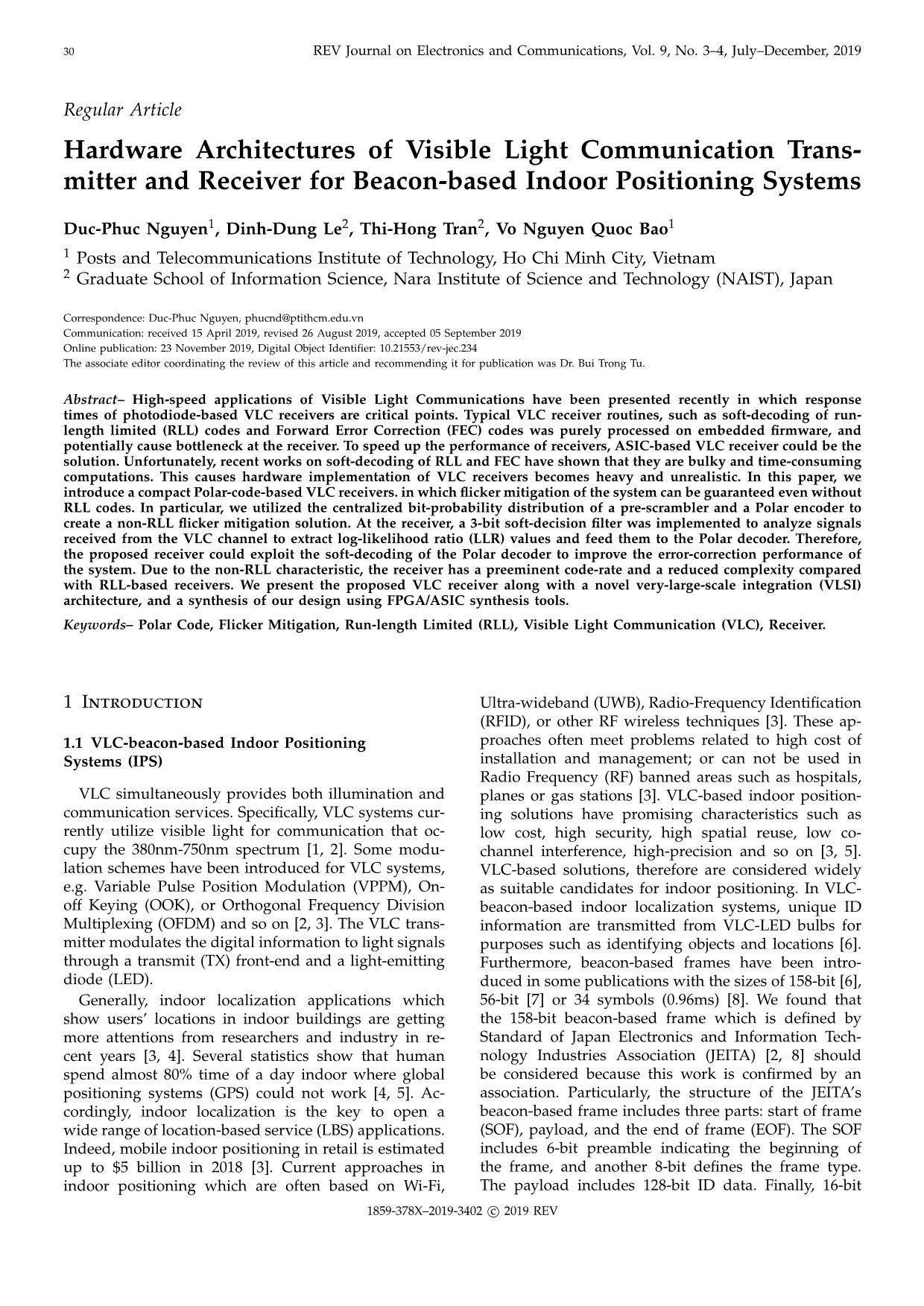
Trang 1

Trang 2
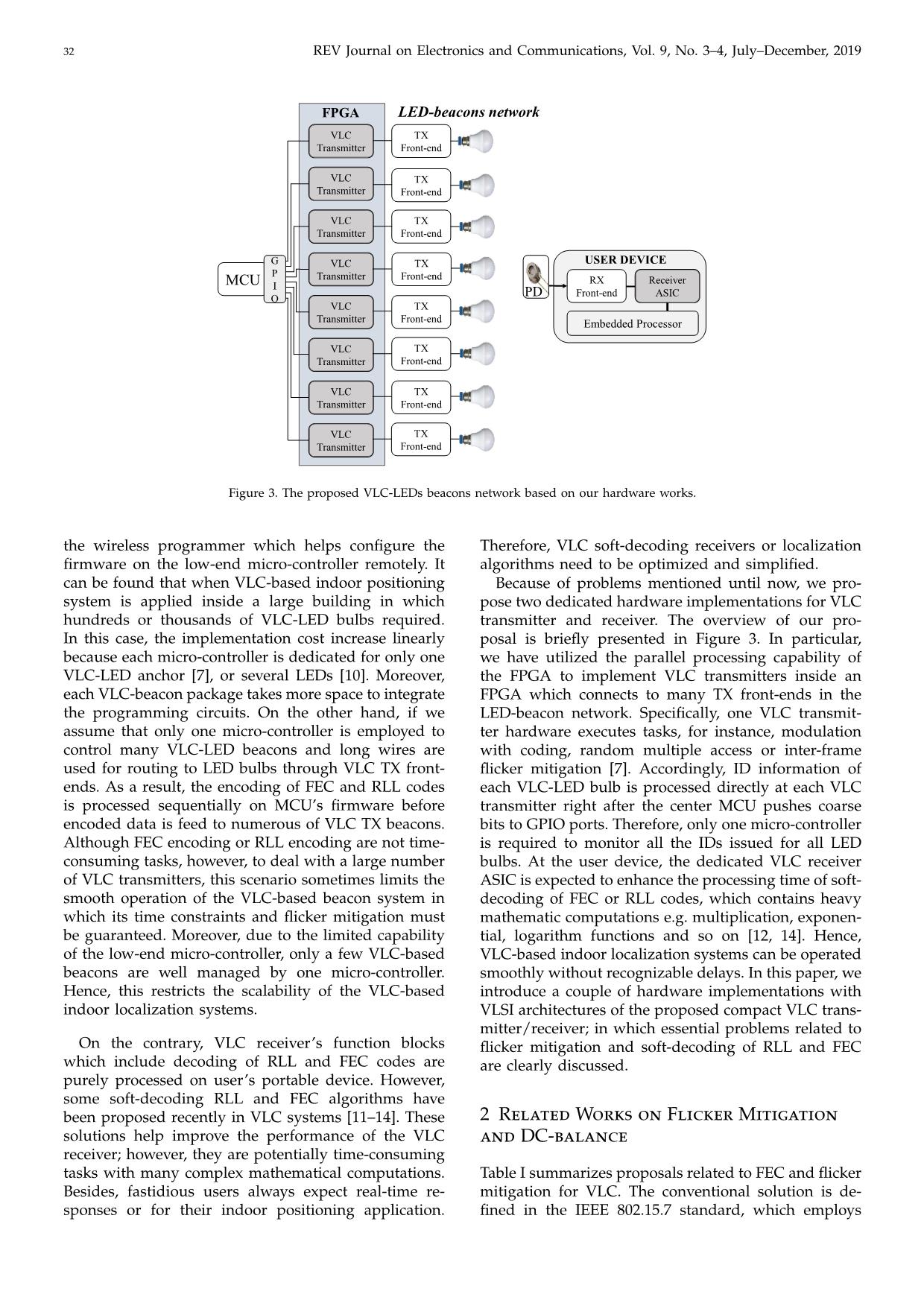
Trang 3
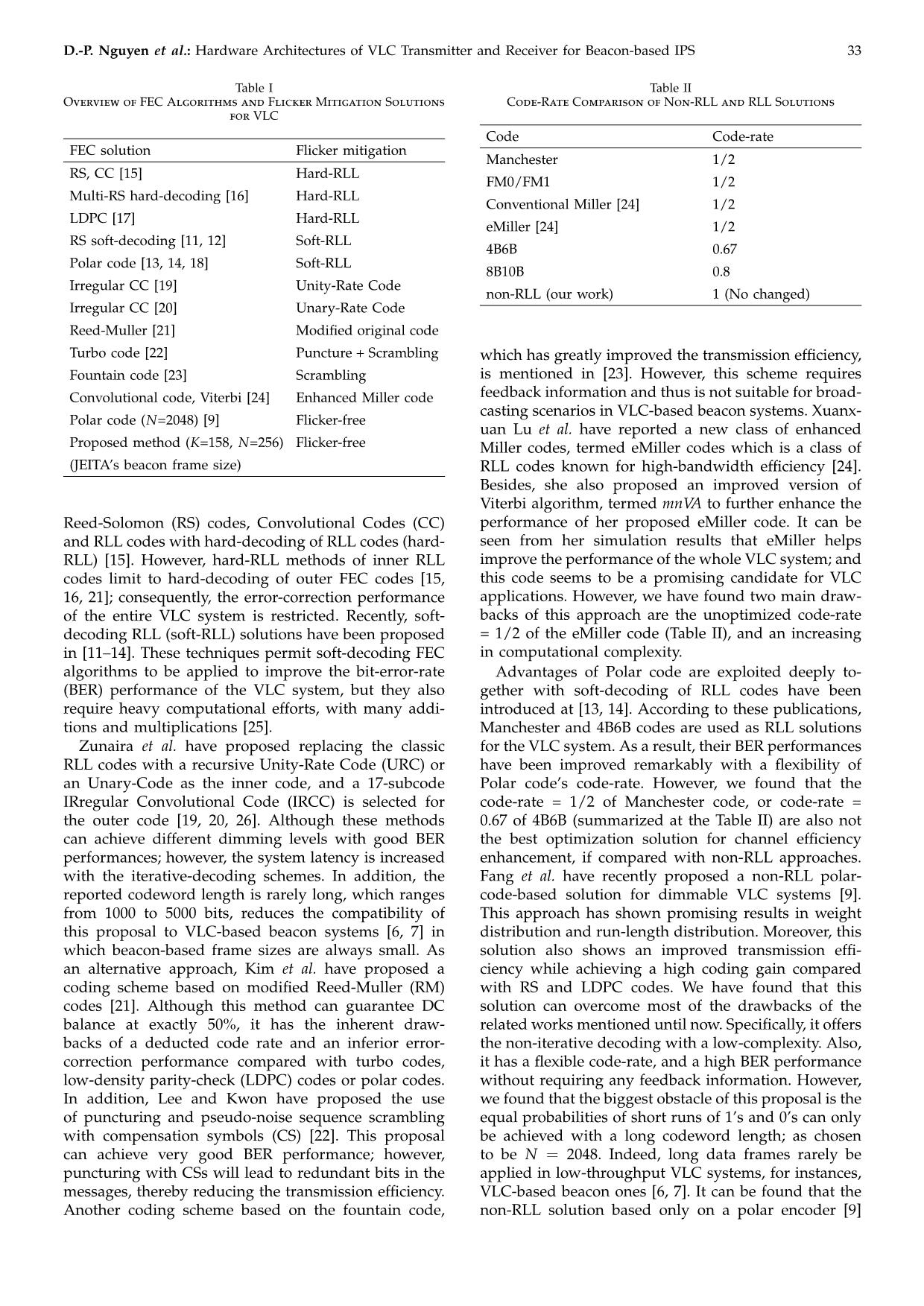
Trang 4
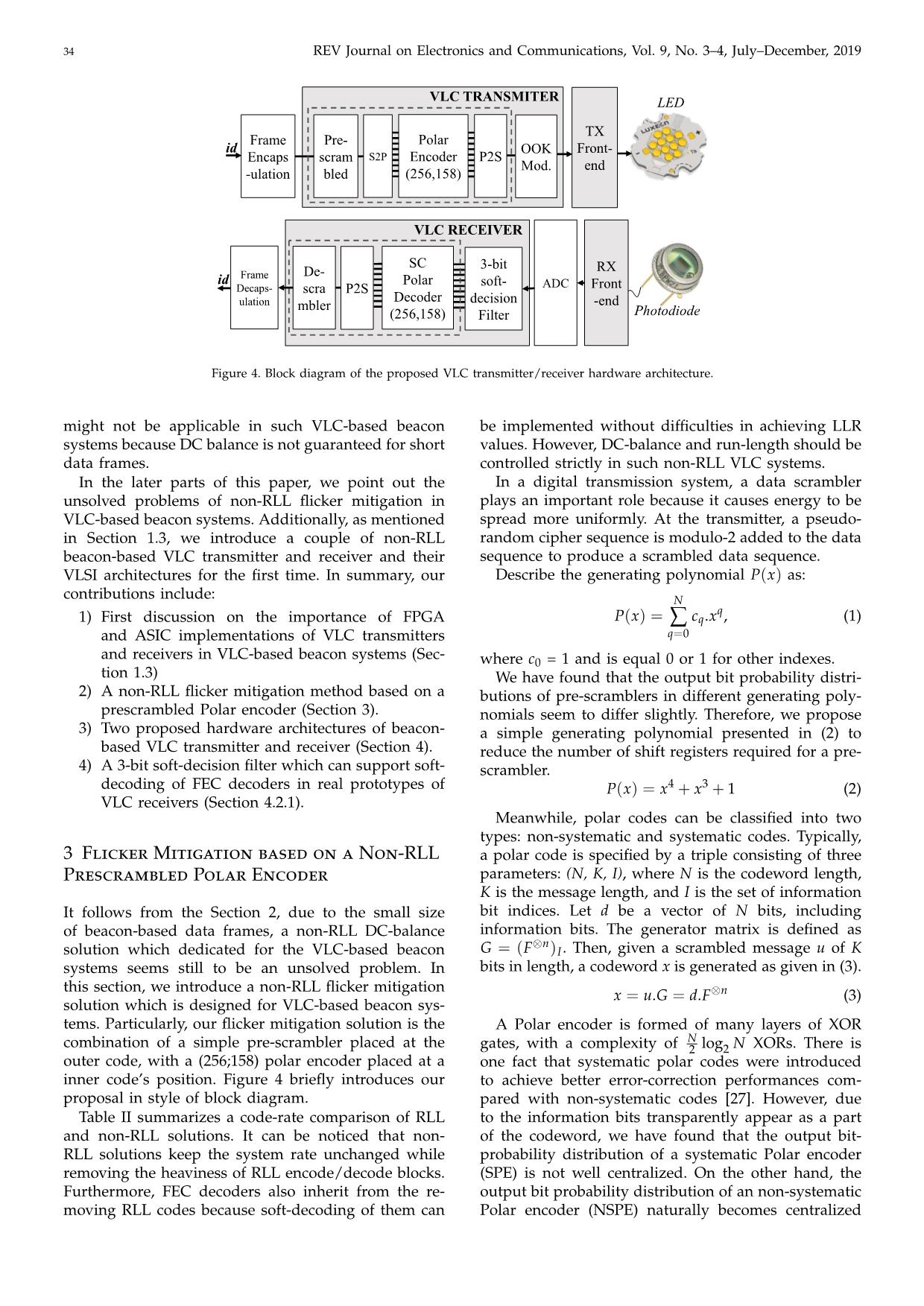
Trang 5
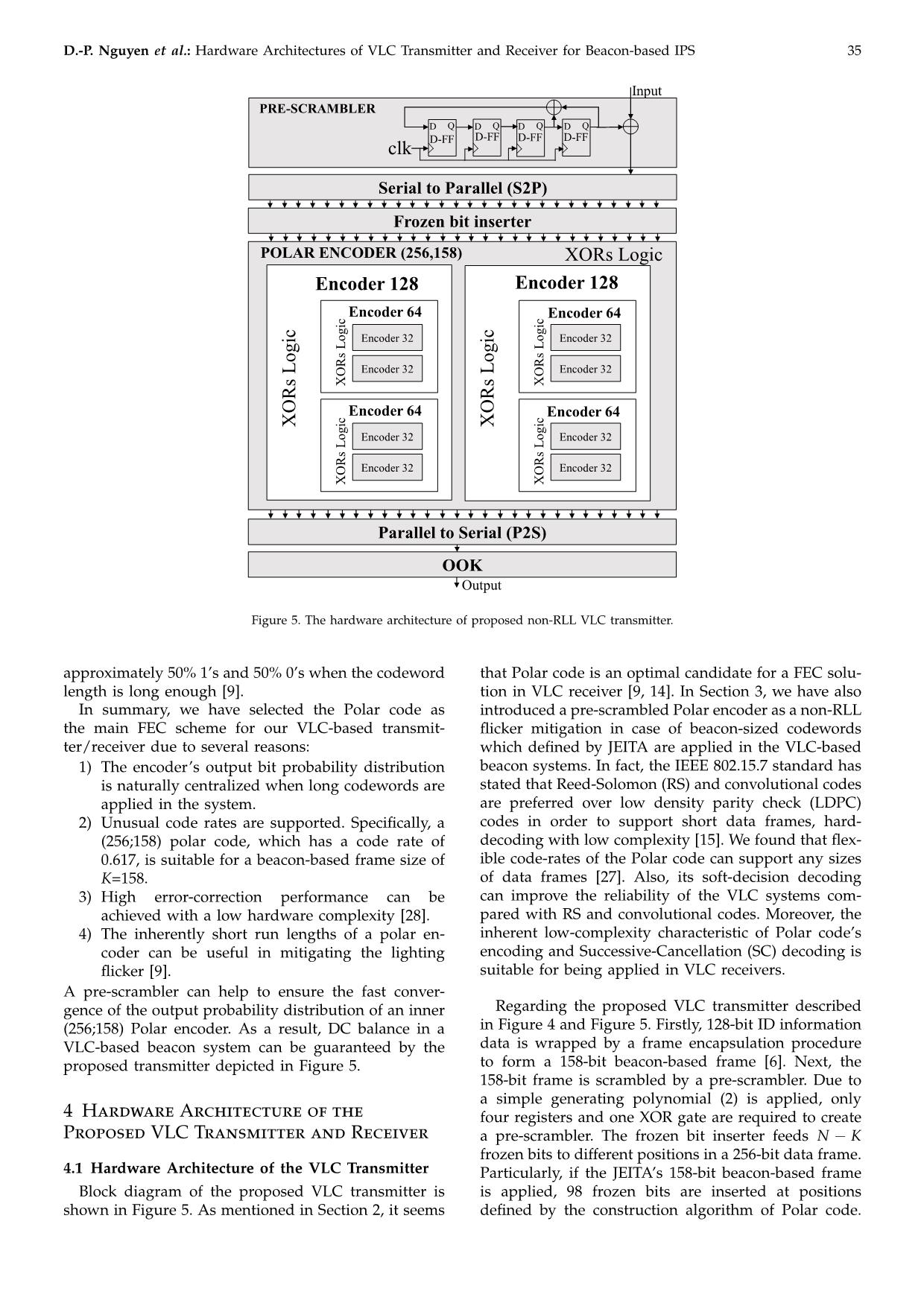
Trang 6
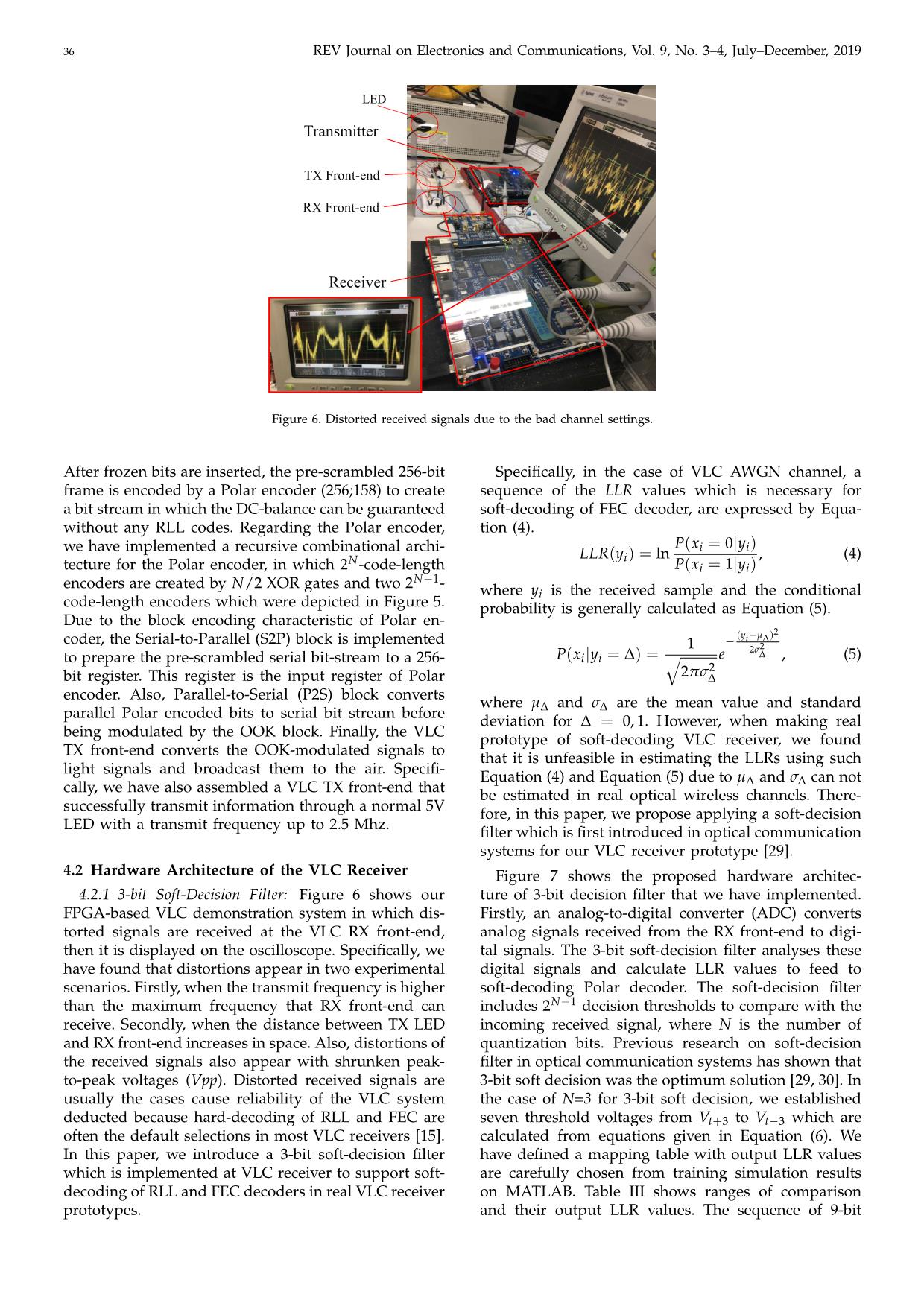
Trang 7
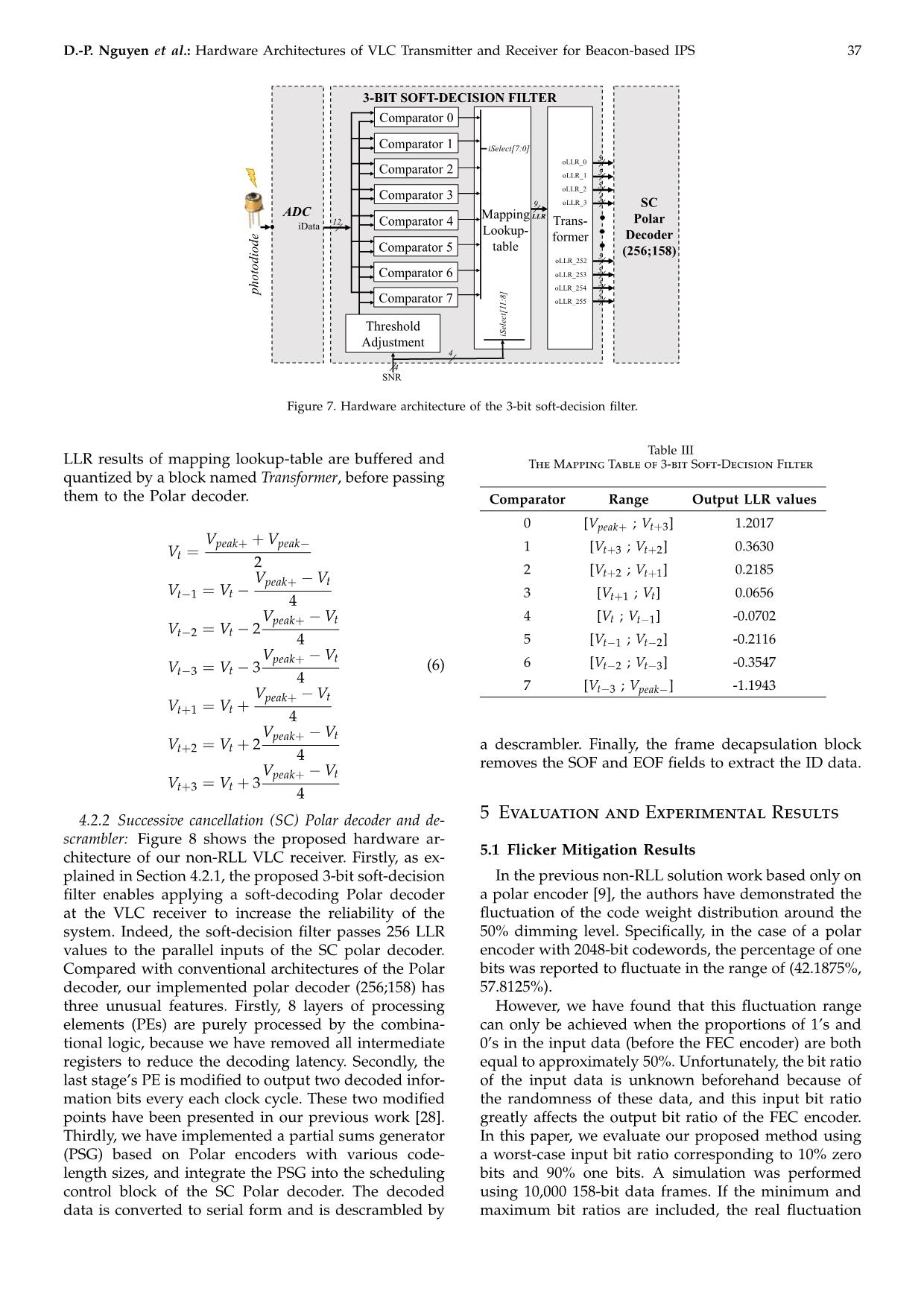
Trang 8
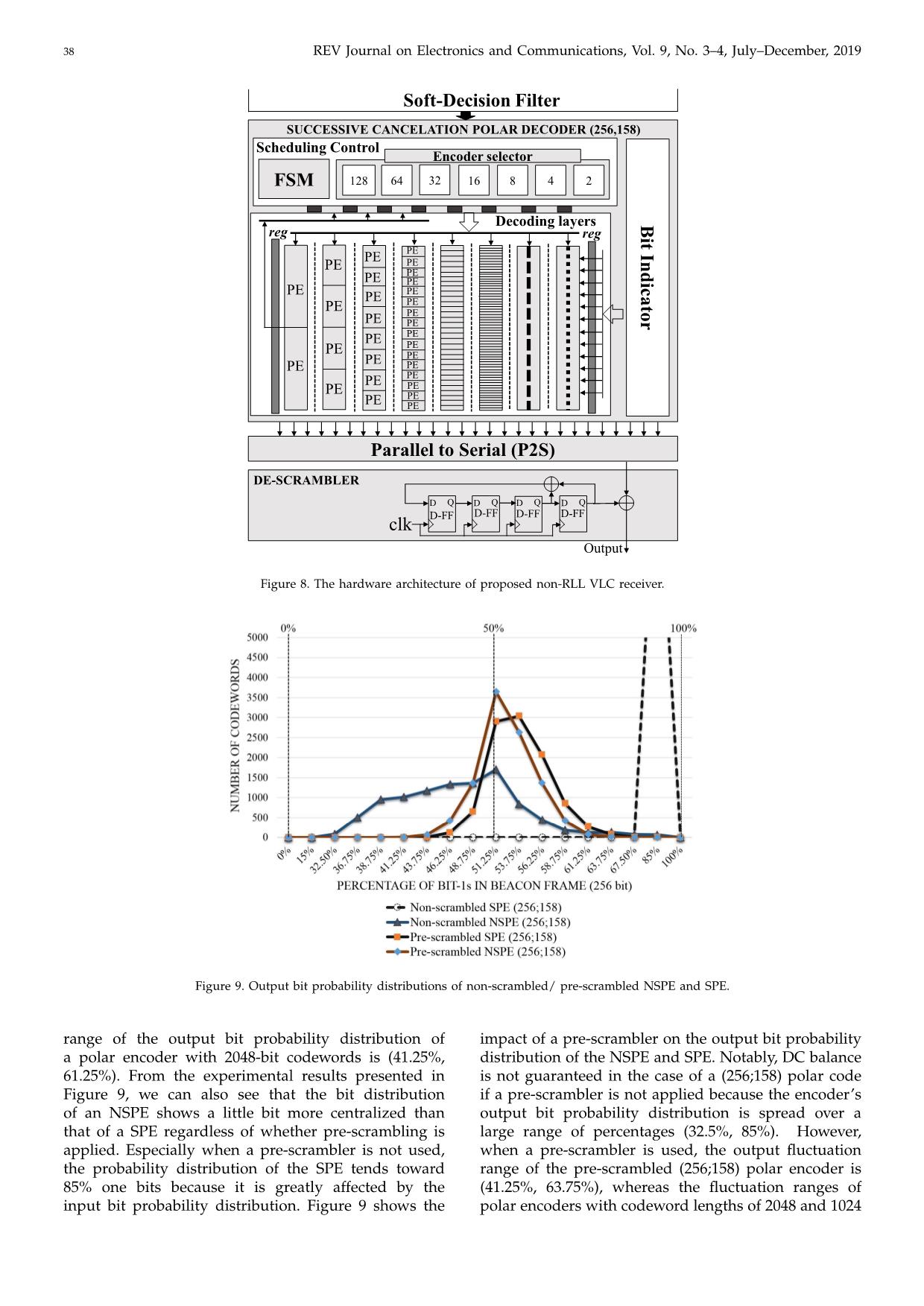
Trang 9
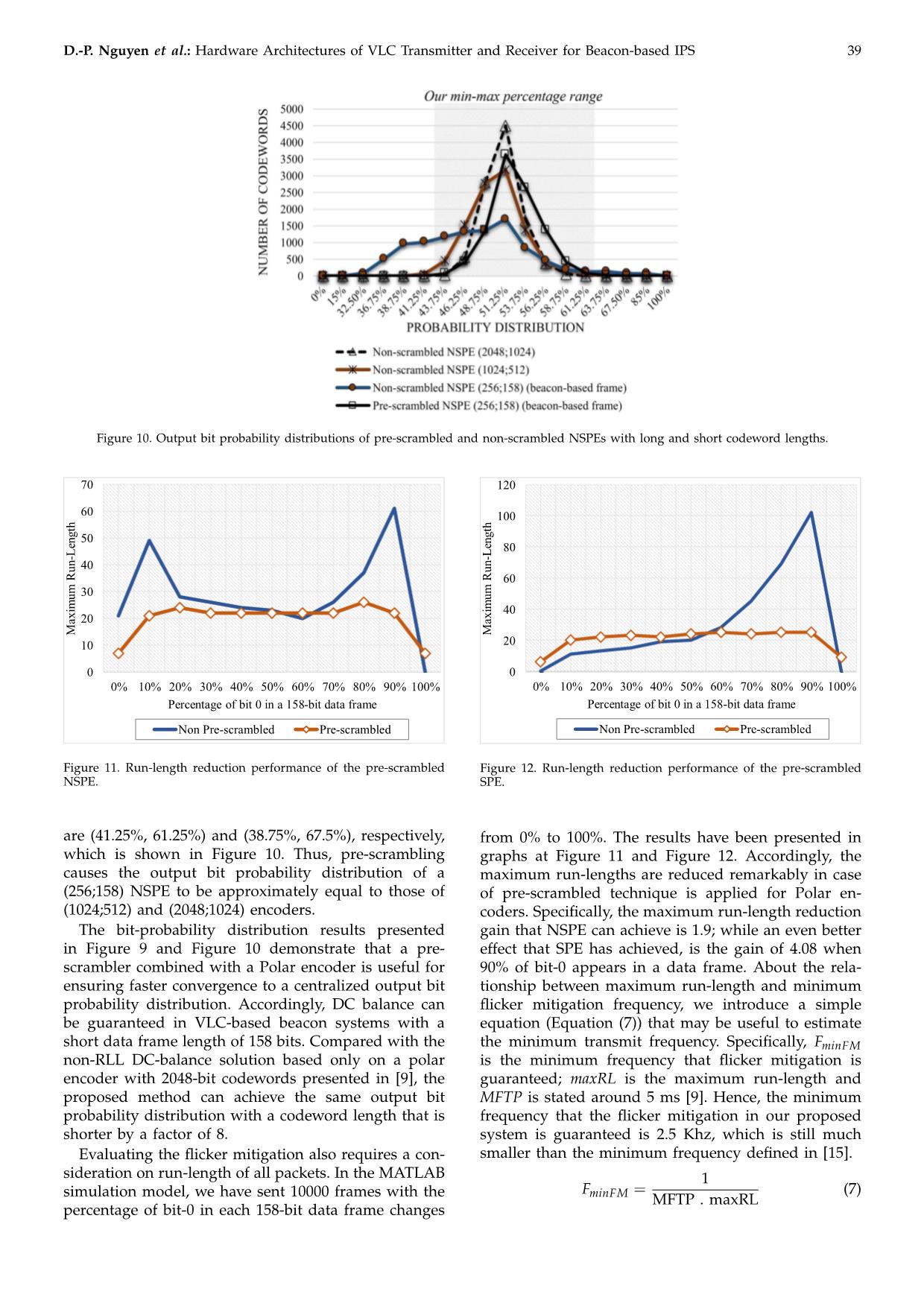
Trang 10
Tải về để xem bản đầy đủ
Tóm tắt nội dung tài liệu: Hardware architectures of visible light communication transmitter and receiver for beacon-Based indoor positioning systems
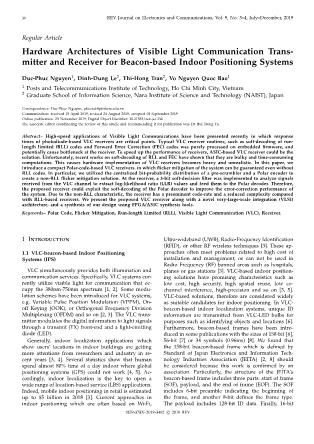
y, the receiver’s maximum systematic Polar codes are applied to evaluate the BER 42 REV Journal on Electronics and Communications, Vol. 9, No. 3–4, July–December, 2019 100 Non-sys Polar Code [This work] Sys. Polar Code [This work] BLS RLL - RS(15,11) [9] 1 BLS RLL - RS(15,7) [9] 10− BLS RLL - RS(15,3) [9] SISO 4B6B + Polar(64,44) [14] LDPC [24] RS(15,7) + eMiller [23] 2 10− Multi-RS(15,7) + 4B6B Hard [12] 3 10− Bit Error Rate (BER) 4 10− 10 5 − 44.555.566.577.588.59 Eb/N0 Figure 13. BER performances of the proposed VLC system with some comparisons in real VLC-AWGN channel. 100 1 10− 2 10− 3 10− Frame Error Rate (FER) Non-sys Polar Code [This work] Sys. Polar Code [This work] 4 10− BLS RLL - RS(15,11) [9] BLS RLL - RS(15,7) [9] BLS RLL - RS(15,3) [9] SISO 4B6B + Polar(64,44) [14] 10 5 − 45678910 Eb/N0 Figure 14. FER performances of the proposed VLC system and some related works in real VLC-AWGN channel. performances. We have selected some typical joint FEC- Polar code-based solutions have preeminent BER per- RLL and non-RLL FEC solutions for comparison. It can formances although their humble code-rates compared be seen that the BER performances of our proposed with the related works. Furthermore, an evaluation of system outperform current related works. Specifically, frame error rate (FER) has been presented in Figure 14 Figure 13 shows that at a code-rate = 0.62, our non-RLL in which our non-RLL solutions also surpass related Polar-code-based system outperforms RS-code-based works introduced in [11, 14, 30]. However, although ones at code-rates 0.49 (11/15 * 4/6), 0.31 (7/15 * 4/6) systematic Polar decoder always shows a better BER and 0.13 (15/3 * 4/6) which are mentioned in [11, 14]. performance than the non-systematic decoder does; the Also, in Figure 13, we also put BER performances of FER performance of these two decoders are always other related works mentioned in [14, 16, 17, 24] into equal in all cases. Actually, this is not a strange discov- the same graph with our BER performance lines. It ery cause it has been mention in previous systematic can also be noticed that, our prescrambled non-RLL Polar decoder work [32]. D.-P. Nguyen et al.: Hardware Architectures of VLC Transmitter and Receiver for Beacon-based IPS 43 6 Conclusions Technologies for Communications (ATC). IEEE, 2018, pp. 214–219. We have introduced a non-RLL flicker mitigation so- [5] L. Feng, R. Q. Hu, J. Wang, P. Xu, and Y. Qian, “Applying lution which consists of a pre-scrambler based on a VLC in 5G Networks: Architectures and Keys Technolo- gies,” IEEE Network, vol. 30, pp. 77–83, 2016. simple generating polynomial combined with a Polar [6] S. Yoshizawa, S. Handa, F. Sasamori, and O. Takyu, “A encoder. The proposed method has a centralized bit simple but effective approach for visible light beacon- probability distribution with the distribution range is based positioning systems with smartphone,” in Pro- determined in (43.75% - 63.75%). Moreover, the maxi- ceedings of the 12th International Colloquium on Signal mum run-length is reduced up to 4.08 times when pre- Processing & Its Applications (CSPA). IEEE, 2016, pp. 32–25. scrambler is applied with a SPE; and up to 1.9 times [7] Q. Liang and M. Liu, “Plugo: a VLC systematic when it is applied with a NSPE. Therefore, DC-balance perspective of large-scale indoor localization,” arXiv: can be maintained even with the short data frames used 1709.06926v1, vol. cs.NI, 2017. in VLC-based beacon systems. Moreover, the non-RLL [8] T. Yamazato, N. Kawagita, H. Okada, T. Fujii, T. Yendo, nature of the proposal reduces the complexity of both S. Arai, and K. Kamakura, “The uplink visible light communication beacon system for universal traffic man- VLC transmitter/receiver with great improvements on agement,” IEEE Access, vol. 5, pp. 22 282–22 290, 2017. information code-rate. Besides, we have introduced a [9] J. Fang, Z. Che, Z. L. Jiang, X. Yu, S.-M. Yiu, K. Ren, soft-decision filter which can help the soft-decoding of X. Tan, and Z. Chen, “An Efficient Flicker-free FEC Cod- polar code is implemented in real VLC receiver proto- ing Scheme for Dimmable Visible Light Communication types to enhance the error-correction performance. As Based on Polar Codes,” IEEE Photonics Journal, vol. 9, pp. 1–10, 2017. a result, BER and FER performances of the proposed [10] Y.-S. Kuo, P. Pannuto, K.-J. Hsiao, and P. Dutta, “Luxa- system have outperformed current approaches while pose: Indoor positioning with mobile phones and visible remaining a good code-rate (0.62). In addition, we have light,” in Proceedings of the 20th annual international con- introduced a couple of hardware architectures for the ference on Mobile computing and networking. ACM, 2014, proposed non-RLL VLC transmitter and receiver which pp. 447–458. [11] H. Wang and S. Kim, “Bit-level soft run-length limited their FPGA and ASIC synthesis results are given in decoding algorithm for visible light communication,” details. IEEE Photonics Technology Letters, vol. 28.3, pp. 237–240, 2016. [12] ——, “Soft-input soft-output run-length limited decod- Acknowledgment ing for visible light communication,” IEEE Photonics Technology Letters, vol. 28.3, pp. 225–228, 2016. This research is funded by Vietnam National Founda- [13] ——, “Dimming control systems with polar codes in tion for Science and Technology Development (NAFOS- visible light communication,” IEEE Photonics Technology Letters, vol. 29.19, pp. 1651–1654, 2017. TED) under grant number 102.02-2018.320 [14] D. D. Le, D. P. Nguyen, T. H. Tran, and N. Yasuhiko, “Joint polar and run-length limited decoding scheme for visible light communications,” IEICE Communication Appendix Express, vol. 7, pp. 19–24, 2018. [15] S. Rajagopal, R. D. Roberts, and S.-K. Lim, “IEEE 802.15. N [b] Thoughput [b/s] = (8) 7 visible light communication: modulation schemes DN [sec] and dimming support,” IEEE Communications Magazine, vol. 50, no. 3, 2012. Power [W] Energy-per-bit [J/b] = (9) [16] H. Wang and S. Kim, “New RLL decoding algorithm Thoughput [b/s] for multiple candidates in visible light communication,” IEEE Photonics Technology Letters, vol. 27, no. 1, pp. 15–17, 2015. Thoughput [b/s] Hardware Efficiency [b/s/m2] = [17] S. Kim, “Adaptive FEC codes suitable for variable dim- Area [m2] ming values in visible light communication,” IEEE Pho- (10) tonics Technology Letters, vol. 27, no. 9, pp. 967–969, 2015. [18] H. Wang and S. Kim, “Decoding of polar codes for in- tersymbol interference in visible-light communication,” References IEEE Photonics Technology Letters, vol. 30, no. 12, pp. 1111–1114, 2018. [1] M. Z. Chowdhury, M. T. Hossan, A. Islam, and Y. M. [19] Z. Babar, H. V. Nguyen, P. Botsinis, D. Alanis, D. Chan- Jang, “A comparative survey of optical wireless tech- dra, S. X. Ng, and L. Hanzo, “Unity-Rate Codes Max- nologies: Architectures and applications,” IEEE Access, imize the Normalized Throughput of ON–OFF Keying vol. 6, pp. 9819–9840, 2018. Visible Light Communication,” IEEE Photonics Technology [2] L. U. Khan, “Visible light communication: Applications, Letters, vol. 29, no. 3, pp. 291–294, 2017. architecture, standardization and research challenges,” [20] Z. Babar, M. A. M. Izhar, H. V. Nguyen, P. Botsinis, Digital Communications and Networks, vol. 3, pp. 78–88, D. Alanis, D. Chandra, S. X. Ng, R. G. Maunder, and 2017. L. Hanzo, “Unary-Coded Dimming Control Improves [3] L. F. Junhai Luo and H. Li, “Indoor positioning systems ON-OFF Keying Visible Light Communication,” IEEE based on visible light communication: State of the art,” Transactions on Communications, vol. 66, no. 1, pp. 255– IEEE Communications Surveys and Tutorials, vol. 19, pp. 264, 2018. 2871–2893, 2017. [21] S. Kim and S.-Y. Jung, “Novel FEC coding scheme for [4] T. Tuan-Kiet, H.-T. Huynh, D.-P. Nguyen, L. Dinh-Dung, dimmable visible light communication based on the T. Thi-Hong, and Y. Nakashima, “Demonstration of a modified Reed–Muller codes,” IEEE photonics technology visible light receiver using rolling-shutter smartphone letters, vol. 23, no. 20, pp. 1514–1516, 2011. camera,” in 2018 International Conference on Advanced [22] S. H. Lee and J. K. Kwon, “Turbo code-based error 44 REV Journal on Electronics and Communications, Vol. 9, No. 3–4, July–December, 2019 correction scheme for dimmable visible light communi- Dinh-Dung Le received the B. Sc. degree at cation systems,” IEEE Photonics Technology Letters, vol. 24, Da Nang University of Technology, Vietnam no. 17, pp. 1463–1465, 2012. in 2009 and M.Sc. degree at National Chiao [23] L. Feng, R. Q. Hu, J. Wang, and P. Xu, “Fountain code- Tung University, Taiwan in 2013. He was a based error control scheme for dimmable visible light lecturer at Hue Industrial College from 2009 to 2016. He received the Doctor of Engineer- communication systems,” Optics Communications, vol. ing degree at Graduate School of Informa- 347, pp. 20–24, 2015. tion Science, Nara Institute of Science and [24] X. Lu and J. Li, “New Miller Codes for Run-Length Con- Technology (NAIST), Nara, Japan in 2019. His trol in Visible Light Communications,” IEEE Transactions research interests include Machine Learning, on Wireless Communications, vol. 17, no. 3, pp. 1798–1810, Visible Light Communications, Digital Signal 2018. Processing, Network Systems. He is currently a regular member [25] T. H. Tran, D. P. Nguyen, and Y. Nakashima, “PER evalu- of IEEE. ation of K-min Viterbi decoder for wireless sensors,” in 2016 10th International Conference on Sensing Technology (ICST). IEEE, 2016, pp. 1–6. [26] D. P. Nguyen, T. H. Tran, and Y. Nakashima, “A Thi-Hong Tran received the B.S. degree (2008) multi-mode error-correction solution based on split- in Physics, and M.S. degree (2012) in Elec- concatenation for wireless sensor nodes,” Journal of Com- tronics and Telecommunication, from Ho Chi munications, vol. 12, no. 2, 2017. Minh City - University of Science (HCMUS), [27] H. Vangala, Y. Hong, and E. Viterbo, “Efficient algo- Vietnam; and Ph.D. degree (2014) in Com- rithms for systematic polar encoding,” IEEE communi- puter Science and System Engineering from cations letters, vol. 20, no. 1, pp. 17–20, 2016. Kyushu Institute of Technology (KIT), Japan. [28] D.-P. Nguyen, D.-D. Le, T.-H. Tran, H.-T. Huynh, and She is currently an Assistant Professor at Nara Institute of Science and Technology Y. Nakashima, “Hardware implementation of a Non-RLL (NAIST), Japan. Her research interests are soft-decoding beacon-based visible light communication MIMO-OFDM wireless LAN system, signal receiver,” in 2018 International Conference on Advanced and image processing, wireless sensor network, etc. She is a regular Technologies for Communications (ATC). IEEE, 2018, pp. member of IEEE and IEICE. 208–213. [29] H. Tagami, T. Kobayashi, Y. Miyata, K. Ouchi, K. Sawada, K. Kubo, K. Kuno, H. Yoshida, K. Shimizu, T. Mizuochi et al., “A 3-bit soft-decision IC for powerful forward error correction in 10-Gb/s optical communication systems,” Vo Nguyen Quoc Bao received the B.E. and M.Eng. degree in electrical engineering from IEEE journal of solid-state circuits, vol. 40, no. 8, pp. 1695– Ho Chi Minh City University of Technology 1705, 2005. (HCMUT), Vietnam, in 2002 and 2005, respec- [30] D.-D. Le, D.-P. Nguyen, T.-H. Tran, and Y. Nakashima, tively, and Ph.D. degree in Electrical Engineer- “Log-likelihood ratio calculation using 3-bit soft-decision ing from University of Ulsan, South Korea, for error correction in visible light communication sys- in 2009. In 2002, he joined the Department tems,” IEICE Transactions on Fundamentals of Electronics, of Electrical Engineering, Posts and Telecom- Communications and Computer Sciences, vol. 101, no. 12, munications Institute of Technology (PTIT), as pp. 2210–2212, 2018. a lecturer. Since February 2010, he has been [31] O. Dizdar and E. Arıkan, “A high-throughput energy- with the Faculty of Telecommunications, PTIT, where he is currently an Associate Professor. He is a Senior Member efficient implementation of successive cancellation de- of IEEE. His research interests include wireless communications coder for polar codes using combinational logic,” IEEE and information theory with current emphasis on MIMO systems, Transactions on Circuits and Systems I: Regular Papers, cooperative and cognitive communications, physical layer security, vol. 63, no. 3, pp. 436–447, 2016. and energy harvesting. He is currently serving as the Editor of [32] E. Arikan, “Systematic polar coding,” IEEE Communica- Transactions on Emerging Telecommunications Technologies (Wiley tions Letters, vol. 15, no. 8, pp. 860–862, 2011. ETT) and VNU Journal of Computer Science and Communication En- gineering. He is also a Guest Editor of EURASIP Journal on Wireless Communications and Networking, special issue on "Cooperative Cog- nitive Networks" and IET Communications, special issue on "Secure Physical Layer Communications". He served as a Technical Program co-chair for ATC (2013,2014), NAFOSTED-NICS (2014, 2015, 2016), REV-ECIT 2015 and ComManTel (2014, 2015), and SigComTel (2017, Duc-Phuc Nguyen received the B.Sc. degree 2018). He is a Member of the Executive Board of the Radio-Electronics in Electronics and Telecommunications (honor Association of Vietnam (REV) and the Electronics Information and program) in 2012, and Master degree in Elec- Communications Association Ho Chi Minh City (EIC). He is currently tronics Engineering - Microelectronics in 2015, serving as vice chair of the Vietnam National Foundation for Science both from the University of Science, Ho Chi and Technology Development (NAFOSTED) scientific Committee in Minh City (HCMUS), Vietnam. From 2012 to Information Technology and Computer Science (2017-2019). 2015, He was a lecturer and researcher at Fac- ulty of Electronics and Telecommunications (FETEL), HCMUS. He received the Doctor of Engineering degree at Graduate School of Information Science, Nara Institute of Science and Technology (NAIST), Nara, Japan in 2018. Since October 2018, he’s been affiliated with Faculty of Telecommunications, Posts and Telecommunication Institute of Technology, Ho Chi Minh Campus as a lecturer-researcher. He is now a postdoctoral research fellow at ETIS UMR-8051, ENSEA, Paris-Seine University, France. He received the best paper award at ATC’18, and the best oral presentation awards at FOSCOM’18 and ICFCC’17. His research interests include Error-Correcting Codes, Polar and LDPC Codes, FPGA & VLSI-based design, Optical Wireless Communications, Coding for Memories and Storage Systems. He is currently a regular member of IEEE, IEEE Young Professionals and IEEE Photonics Society.
File đính kèm:
 hardware_architectures_of_visible_light_communication_transm.pdf
hardware_architectures_of_visible_light_communication_transm.pdf

